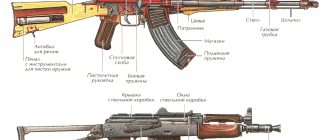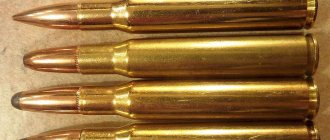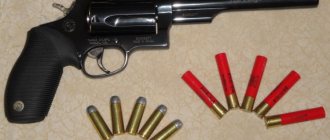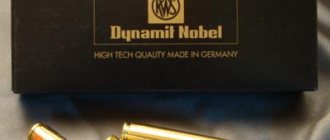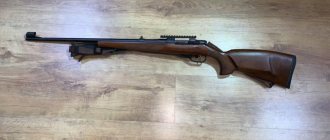In the USSR, the 5.6 mm cartridge, of course, was well known for a long time - and not only by hunters. According to the most conservative estimates, the “Voroshilov Shooter” badge was awarded to six million young (and not so young) citizens who underwent initial training on bolt-on “small guns”.
"Comrades Voroshilov and Gorky at the shooting range." Artist Vasily Svaroga, 1933
But the use for military, espionage and police purposes did not work out. The cartridge was forever labeled “sporting and hunting.” Nevertheless, sports in the USSR have always been held in high esteem not only by civilians, but also by the military. It was for them that the most interesting samples were created...
Gun
Israeli intelligence services used the Beretta M71 pistol chambered in .22lr in the 60s and 70s - and, it seems, quite successfully. But no matter what legends and myths are made about the brave Jewish intelligence officers, you need to understand that they used small-caliber cartridges, let’s be honest, not out of a good life - out of poverty.
Judge for yourself: the country is small, there is no military-industrial complex of its own, there are enemies all around, the economy largely depends on donations from “outside”, it is simply ridiculous to seriously talk about the production of special-purpose weapons intended for liquidations. Not only will such weapons be low-volume and therefore expensive, but just imagine how much money will have to be spent on R&D! So the sons of Zion had to compensate for the performance characteristics (tactical and technical characteristics) of the small-caliber cartridge with masterly shooting accuracy and personal perseverance.
The USSR was a different story: Soviet intelligence was at the forefront of the fight against world imperialism, so no money was spared on it.
If anyone needed, say, a shooting cigarette case chambered for a silent cartridge, even eminent designers took the lead and quickly fulfilled the order.
So, both during the Great Patriotic War and in the post-war period, domestic security forces disdained the 5.6 mm cartridge - they had their own toys, more powerful, and with a larger caliber.
At the same time, of course, there was a fairly decent small-caliber “short-barreled” gun in the Soviet Union - albeit with military roots. For military athletes, the good old “revolver” was redesigned; a team led by G.V. Sevryugin developed sports models R-3 and R-4 with a floating chamber, created on the basis of the TT.
5.6 mm P-3 pistols designed by G. V. Sevryugin
And the whole country fired from the Margolin MCM pistol. In the 90s, by the way, “Margolin” was quite successfully cut both by the length of the trunk and by name. “Margot” would hardly be inferior in any way to the same “Beretta M71”.
5.6 mm pistol "Margot"
About the 5.6x39 cartridge
Let's talk about the hunting qualities of this cartridge. When developing hunting cartridges, an approximate list of animals is always determined for the shooting of which it can be used, and these are: roe deer, saiga, chamois, musk deer, wolf, fox, marmots, and almost all types of real seals.
For the listed types, the cartridge has sufficient, but not excessive, lethality at the minimum firing distance, and sufficient, but not minimal, at extreme distances. Birds that can be hunted include capercaillie, black grouse, and, under certain conditions, goose.
Let's see how the 5.6x39 cartridge bullet acts when shooting at animals much larger and smaller than those listed. Let's look at the table and see that at short distances the bullet carries a supply of energy that seems to be sufficient to hit even such large animals as an elk or a red deer.
Tests carried out at one time showed that moose shot with this cartridge at close range on the shoulder blade and even on the chest left wounded, and those killed a little later gave a fairly similar picture. The semi-sheathed bullet made a significant tear in the animal’s skin and a rather large shallow wound in the muscle tissue with an extensive hematoma.
When hit in the chest, no ribs were punctured or broken, and the bullet did not penetrate into the chest cavity. A careful examination of the wounds showed that the torn muscles contained very small particles of the bullet - copper casing and lead, which means that the bullet worked almost like an explosive. Returning to the table and looking at the amount of bullet energy at distances up to 100 meters, we will see that this energy, note that it is quite large, is endowed with an object consisting of fragile materials and a very small mass, only 3.5 g.
When this bullet meets the carcass of an animal that has fairly dense muscle tissue and durable skin, the released energy tears it into small particles and there is simply nothing to penetrate further. We observed a similar picture even when shooting at saigas from a distance of 20–30 meters. When a bullet hit the ribs, a huge (relative to the size of the saiga) wound was formed, a section of skin measuring approximately 8x8 cm disappeared, and the thin muscle layer from the ribs practically disappeared, but there was no penetrating wound. The bullet also disappeared, that is, it completely collapsed.
Nevertheless, the saiga died, dying from shock, and not from damage to internal organs. But to bring down a large animal, the shock of being hit by such a small bullet is not enough, because the mass of an elk is almost 10 times greater than the mass of a saiga.
When shooting at elk at 100–150 meters, strange as it may seem, the number of elk killed at the shooting site, that is, not wounded, was significantly higher, despite the fact that the bullet had already significantly lost speed.
This happens because, due to the small cross-sectional area of the bullet, its penetrating ability into the animal carcass is quite high, especially since the loss of a significant part of the energy has reduced its ability to deform. This cartridge has amazing accuracy, of course, with high-quality weapons, and if you still have the opportunity to use an optical sight and aim well at a place, for example, at the cervical vertebrae, spine or heart, then you can kill a large animal.
Now a little about shooting such relatively small animals as fox, capercaillie, etc. What happens in this case when a bullet hits? As noted above, the bullet of the 5.6x39 cartridge carries a lot of energy, and although the strength of the skin and muscle density of these animals is not as great as that of an elk or deer, and the bullet does not scatter “into dust,” it is highly fragmented, and not just into the shell and core, and each of these components into even smaller parts.
Huge wounds in these animals are formed not only directly by fragments of the bullet, but also by pieces of crushed bones and muscles, and even by blood, which is located in the capillaries of the muscles formed from the impact of the bullet, i.e., a so-called “temporary pulsating cavity” appears. And all this “mash”, tearing the skin, flies out from the opposite side, making a huge hole. This result was demonstrated by shooting several large herring gulls, shot on the ice from a distance of 40–80 meters, in the process of catching seals.
After being hit by a semi-shell bullet, the entire carcass was practically carried away, leaving only the paws, head with neck and back. This nature of the wounds is a sign of the excessive lethality of the bullet for a given object of hunting, which means that animals of this size can only be shot at distances when the bullet has already lost its speed and with it a significant part of its energy, that is, no closer than 150 meters. Once again I want to remind you that we are talking about a semi-shell bullet.
When assessing the ballistics of this cartridge, I have some questions. The data that is placed in the table is taken from the book “Hunting Rifle” by M. Blum and I. Shishkin, but we must not forget that they are already more than 25 years old. The only manufacturer of 5.6x39 cartridges is currently the Tula Cartridge Plant, which does not show its ballistics in its prospectuses.
I would like to see the results of factory shooting, as they are given, for example, by the Barnaul cartridge plant in their prospectuses. They are needed at least so that buyers can compare 5.6x39 and .223 Remington cartridges, and this information should be available in every store selling these cartridges, especially since IZHMASH produces Bars carbines for both of these cartridges.
Comparison of ballistic indicators (according to available data) is not in favor of the domestic cartridge, and there is only one apparent reason for this - the different shape of the bullet. The mass of the bullet is almost the same, the initial speed is also the same, the shooting conditions, if not the same, are very close. What remains is the shape of the bullet, that is, its ability to overcome air resistance.
And here we see that with almost identical initial parameters, the .223 Remington cartridge produced by the Barnaul Cartridge Plant has a bullet speed at a 300-meter distance that is 100 m/s higher than the bullet of the 5.6x39 cartridge.
The question arises: “Why not replace the bullet of our domestic 5.6x39 cartridge with a .223 Remington bullet with a better ballistic coefficient? Or don’t you want to improve it, or don’t want to deal with it?” By the way, then the barrels could be made with the same rifling pitch for both cartridges.
In conclusion, it must be said that tests of the 5.6x39 cartridge with a semi-jacketed bullet showed good results in all respects in seal and saiga fishing, which cannot be said about shooting marmots. In the process of hunting these animals, it quickly became clear that the cartridge had excessive power.
If the shooting distance did not exceed 100 meters, the destruction caused by a bullet when it hit any part of the marmot carcass was so significant that it noticeably reduced the quality of the skin, the only exception being a hit in the head, because According to the rules for accepting the skin, even its absence was not defective.
The conclusion suggested itself: it is necessary to either reduce the power of the cartridge, or put a full jacket on the bullet. We tried both. The jacketed bullet generally showed good results, however, during close shooting (no further than 50 meters), quite often there was complete destruction of the bullet and, as a result, significant damage to the skin, almost as in the case of the semi-jacketed bullet. A low-power cartridge was also made.
But we must not forget that the test shootings were carried out from a self-loading carbine, which means that the weakened cartridge had to ensure normal operation of the automation. M.N. Blum ensured that the automation worked well on a cartridge with an initial bullet speed of 620 m/s. The new cartridge fully satisfied all the requirements of the marmot fishery.
Essentially, at the first stage of use of the 5.6x39 cartridge, it was presented in three modifications: with a semi-jacketed bullet, with a shell bullet, and weakened with a semi-jacketed bullet. Somewhat later, this cartridge began to be used as a sports cartridge for shooting in the “running deer” exercise, reducing the mass of the jacket bullet to 2.8 g, but increasing the initial speed of this lightweight bullet to 1050 m/s.
Igor Belousov April 24, 2012 at 00:00
Semi-automatic rifle
In the mid-twentieth century, the axiom “a bolt-action rifle is more accurate than a semi-automatic machine” was not questioned. But what to do if the main army “sniper” is self-loading? But the army needs a lot of snipers; there should be them in every motorized rifle squad. They need to be taught, and the sooner the better.
Therefore, in 1968, designer Evgeny Dragunov tried to give birth to a sister for his famous SVD: the TSV-1 rifle (training sniper rifle) had the same controls, but it used a 5.6 mm cartridge.
5.6 mm rifle TSV-1
It was assumed that the TSV would be used for initial training of sniper shooters, but the matter was limited to an experimental batch, and the rifle never went into production. It's a pity: it looks like a very nice machine...
Originally from the USSR? The unexpected history of the 6.5x38 Grendel cartridge
The developers of this cartridge, which is more powerful compared to 5.56×45 caliber ammunition, took as a basis the case of the Soviet 7.62-mm machine gun cartridge (7.62×39), re-compressing the barrel to accommodate a bullet with a diameter of 6.5 mm. Of course, if we go into detail, the ears of the Soviet sports cartridge 5.6×39, known abroad as .220 Russian (with a brass sleeve) due to its production in Finland, also stick out behind the “grendel”. But, in this case, this does not matter, since my story is not devoted to the details of the creation of the 6.5 mm Grendel cartridge, but to unknown facts from Russian weapons history related to the history of 6.5 mm cartridges. I will only note that there is reason to mention here another relatively fresh “American”, which we know as the 6.5 mm Creedmoor, developed on the basis of the .308 Winchester cartridge case.
From left to right. Cartridges 7.62x39, 5.6x39 “Running Deer” (.222 Russian) and 6.5x38 (6.5 mm Grendel). Photo: www.thefirearmblog.com
I met Alexander Shevchenko in the mid-90s of the last century in the testing department of small arms and close combat weapons at the Rzhevka training ground of the GRAU of the Ministry of Defense of the Russian Federation. A little later, he made a splash throughout the country with his project for the Cheetah submachine gun, but this was far from the first of the original weapons he developed, which we will definitely talk about later. What is more important now is that, on his own initiative, Alexander experimented with ammunition of new calibers. It all started in 1982, in Kushka, where Lieutenant Shevchenko arrived to serve as an assistant in the missile and artillery service of the motorized rifle regiment located there. Due to its location - the southernmost point of the USSR, right on the border with Afghanistan, during the presence of a limited contingent of Soviet troops in this country, the regiment performed specific tasks, which included the exchange of out-of-service weapons “across the river” for new ones.
Kushka. Regiment location. 1980s.
Without directly participating in hostilities, Alexander had the opportunity to communicate almost on a daily basis with colleagues who provided exchange operations and, through the RAV, collected information about the operation of small arms in the warring units. Particular attention was paid to complaints from the troops about the insufficient effectiveness of the 5.45x39 cartridge in mountain conditions. Despite the high initial speed, the light 5.45 mm bullet did not have the necessary wind resistance and penetration against natural obstacles. As a result of thoughts and calculations, Lieutenant Shevchenko assembled an experimental cartridge from a 6.5 mm bullet from a biathlon rifle cartridge and a 7.62 mm machine gun cartridge (7.62×39) re-compressed for it. That is, in fact, the modern 6.5x38 Grendel cartridge physically appeared not 20 years ago, but back in 1982 in Turkmenistan in the workshops of the RAV service. This is how the Soviet “grendel” turns out... In total, about 200 6.5x39 cartridges were produced, which were fired on a converted AKM assault rifle, the barrel of which was replaced with a re-sharpened one from a biathlon rifle. The results of the experiments were sent to the GRAU and later, already serving at Rzhevka, Alexander Shevchenko conducted serious research work on the topic of the 6.5 mm machine gun cartridge, which confirmed the feasibility of considering the 6.5 mm complex as the main army one.
From left to right. 6.5 mm Grendel cartridge (6.5x38), 6.5 mm Shevchenko machine gun cartridge (6.5x39) and 5.45 mm machine gun cartridge (5.45x39). Photo by Mikhail Degtyarev
The next time Shevchenko returned to the topic of “6.5 mm” was in 1986 at a repair base in Uzbekistan (Tashkent, Solnechnoe). And the reason again was the experience of communicating with the “Afghans” - weapons from combat units arrived at the base for repair and restoration, and Alexander became interested in the “killed” extreme firing modes of 7.62 mm Kalashnikov machine guns (PK/PKM). The problem was that at ambient temperatures significantly higher than the test 50°C (cartridges in direct sunlight could heat up to 70°C), during intense firing modes the gas outlet becomes hot, resulting in a significantly increased rollback speed of the moving parts machine gun. As a result, there is a possibility of inertial disassembly of the cartridge when it is pulled out of the tape. And again, literally looking into the future, Alexander Shevchenko, already being a captain and head of a small arms repair shop, came to the conclusion that it was necessary to change, first of all, the diameter of the bullet of a promising cartridge, and with it the abandonment of the archaic rim to ensure direct feed . The experimental cartridge was assembled using the same 6.5 mm bullet and a 7.62×51 cartridge case without a welt. In terms of characteristics, the 6.5 mm Shevchenko rifle cartridge was closest to the 6.5 mm Creedmoor cartridge, which appeared 20 years later. This cartridge was not tested with a machine gun - test firing was carried out on a modified 6.5-mm biathlon rifle, and a specially seconded GRAU officer came to Tashkent to obtain the results.
From left to right. 6.5 mm rifle cartridge (6.5x54) for the “Running Boar” and biathlon exercises, 6.5 mm Shevchenko rifle cartridge (6.5x51) and 6.5 mm Shevchenko machine gun cartridge (6.5x39). Photo by Mikhail Degtyarev
It would seem that there is no way to do without the well-known cliche - “there is no prophet in his own country.” However, not everything is so simple in the evolution of small arms. Especially when it comes to systems that form the basis of small arms weapons of huge armies. Therefore, I will leave the question “Why?” unanswered, but I will draw special attention of readers to the need to use the proverb “There is no prophet in his own country”, recalling the works of Shevchenko. Next time I will talk about Alexander’s experiments with cartridges for PDW (for submachine guns, in other words).
Machine gun
When hearing the words “small-caliber machine gun,” most of the population will raise their eyebrows in bewilderment, while the more educated will immediately recall the overseas submachine gun “American-180.” However, in the 30s of the twentieth century, OSOAVIAKHIM willingly used such products designed by gunsmith Mikhail Nikolaevich Blum for shooting training.
The machine gunners of the Red Army were so needed - but the people’s penny should have been protected.
And a small-caliber cartridge is several times cheaper than a full-fledged rifle cartridge 7.62x54R. As a so-called “parasitic installation,” Blyumov’s rapid-fire guns with a drum magazine of the original design were either installed on top of the body of the Maxim machine guns, or gave them the appearance of a tank or infantry version of the Degtyarev machine guns.
5.6 mm Blum machine gun in easel version
In total, almost three thousand “substitute machine guns” were produced. Blum himself, who was passionate about hunting, proposed using his creation as an automatic hunting carbine: he discovered that five to eight 22-caliber cartridges fired at high speed completely replaced a grape shot. Such a weapon would be quite useful when shooting a wolf, roe deer, or even a small boar.
Manual 5.6 mm Blum machine gun
However, the Soviet state did not support this idea: hunters are too shady people.

